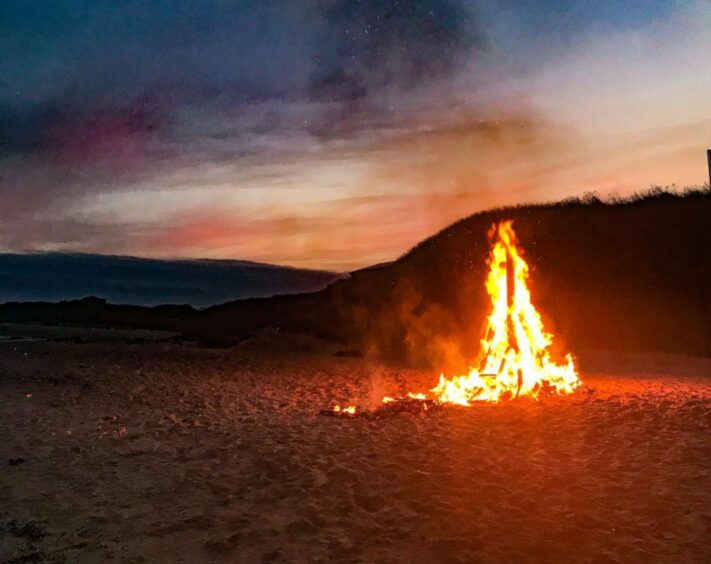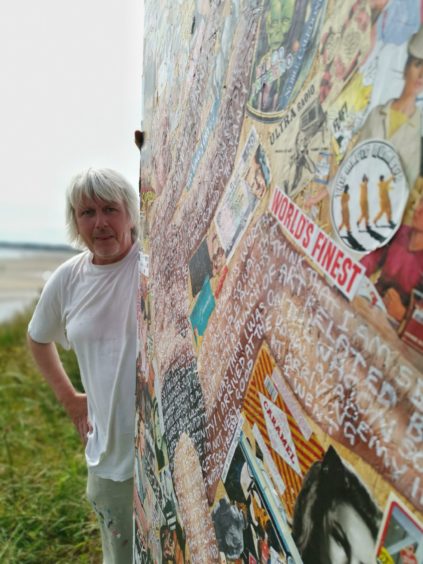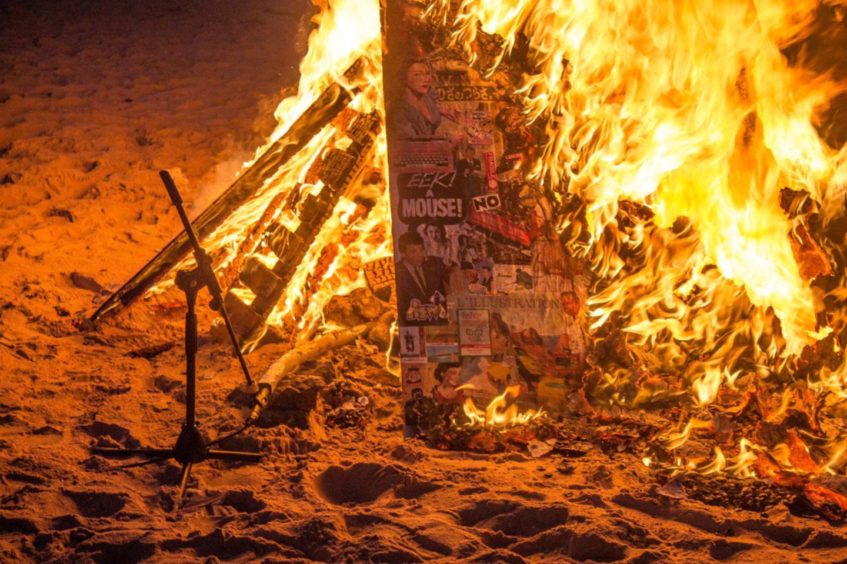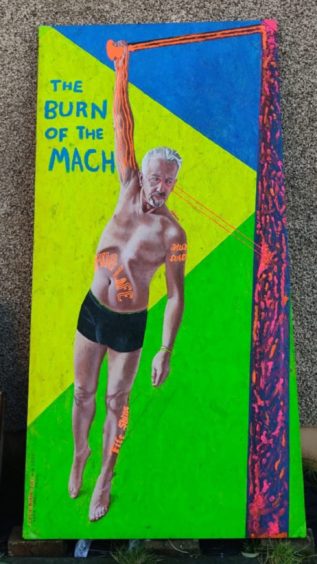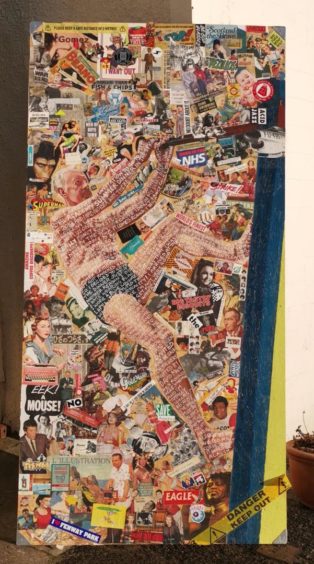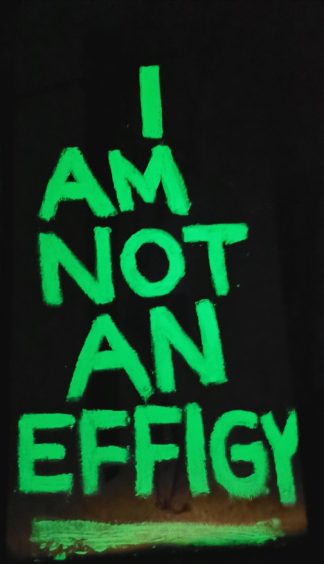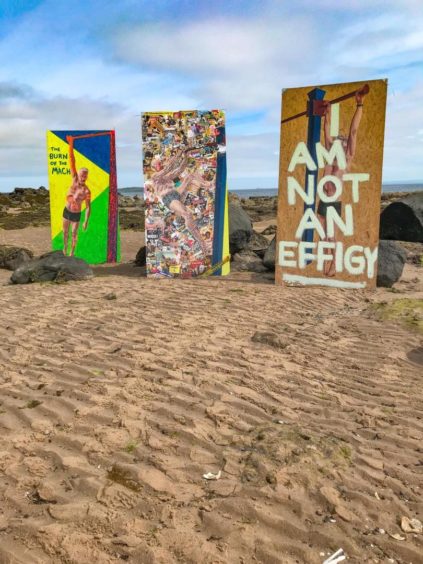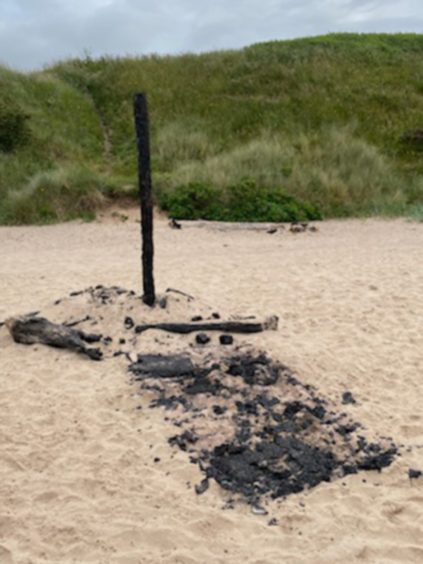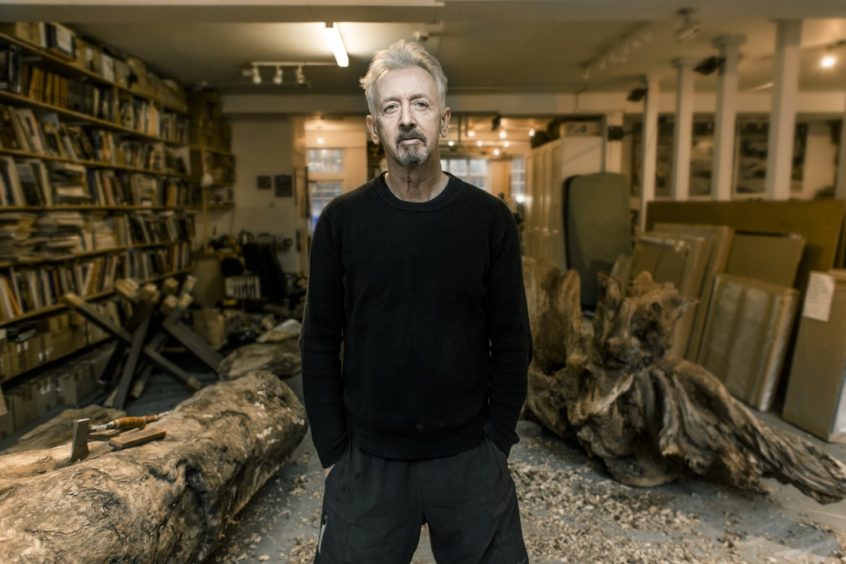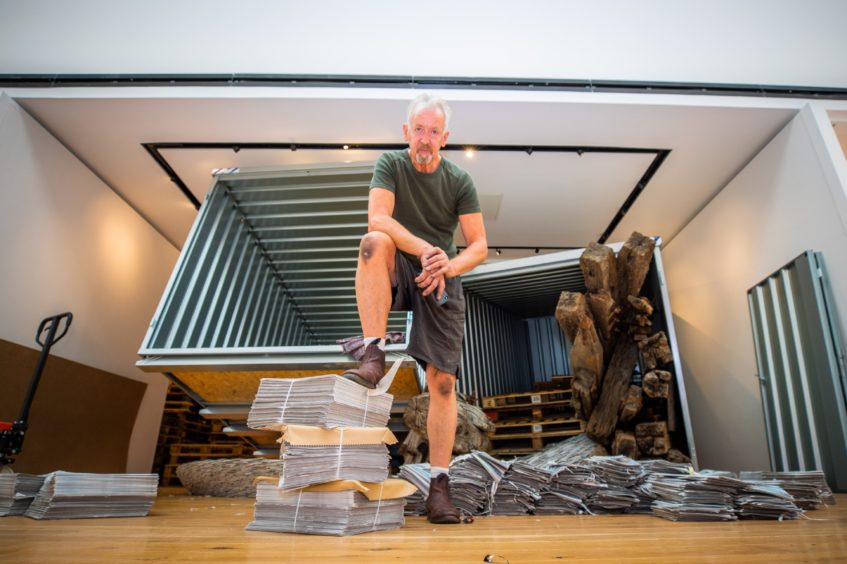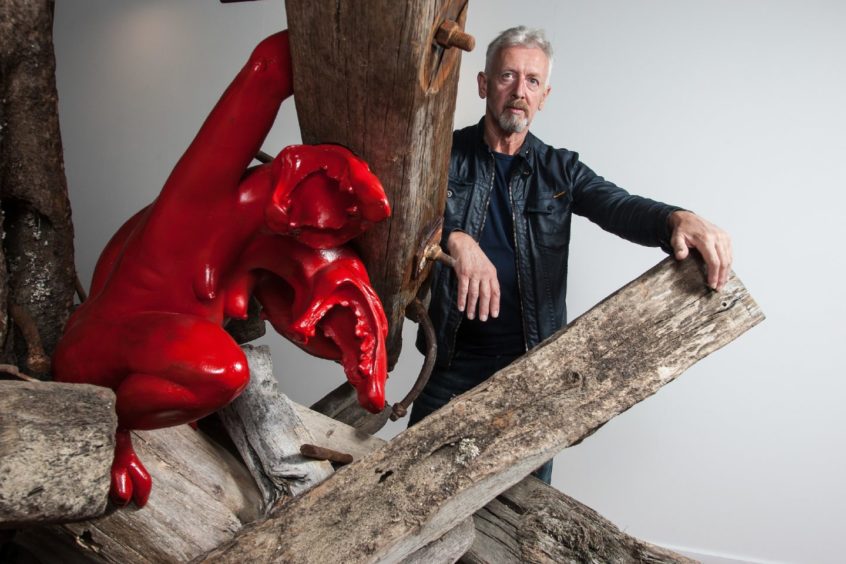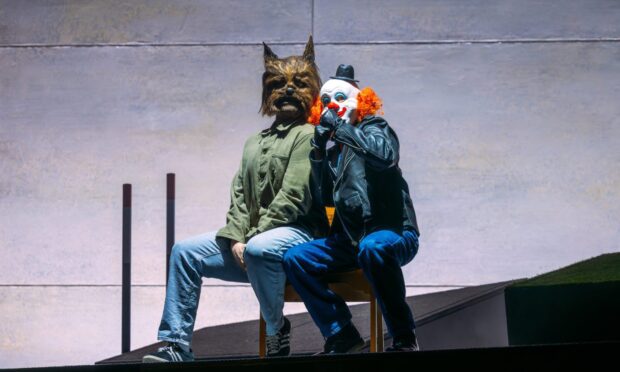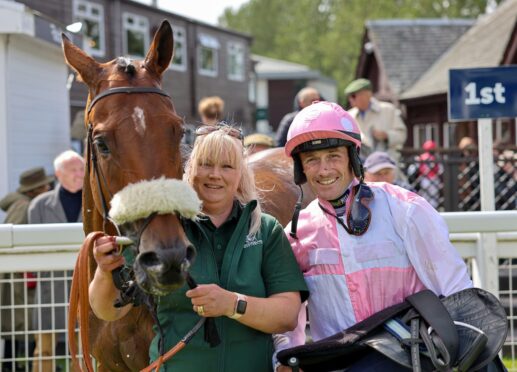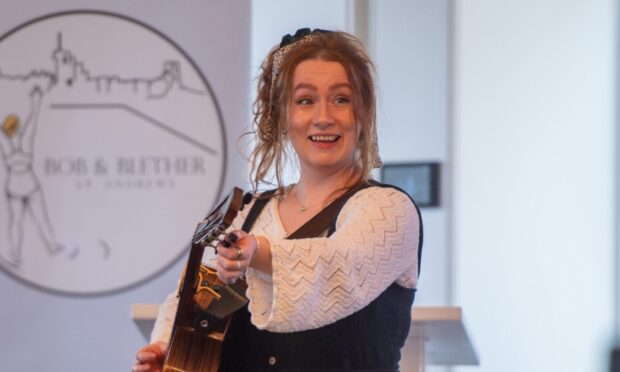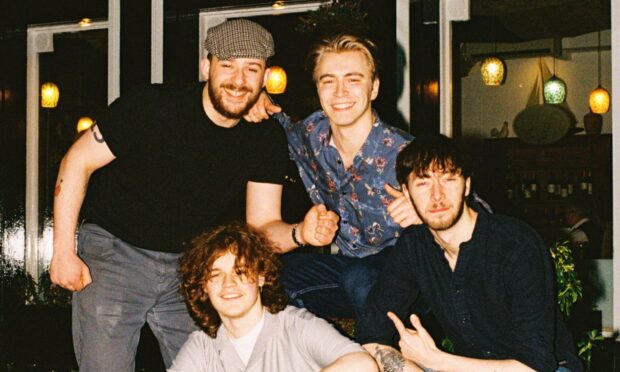Internationally renowned sculptor David Mach watched as a semi-naked effigy of himself was consumed by flames on a Fife beach – and it was all in the name of art!
The Big Mach Burning Man installation was the brainchild of Kelty-based artist Celie Byrne, stand-up-comedian turned artist Phill Jupitus, who lives in Pittenweem, and Cupar-based artist Mark Small.
As the sun set at Lundin Links beach on Wednesday June 30, Celie, Phill and Mark simultaneously set light to the respective panels they had created – and in the words of Celie Byrne, “it went up like a rocket”!
Dramatic scenes as a ‘semi-naked effigy’ of internationally renowned sculptor David Mach is consumed by flames on a #Fife beach – and all in the name of art! Keep an eye on The Courier to find out more… pic.twitter.com/21krnTYEAP
— Michael Alexander (@C_MAlexander) July 1, 2021
Mark Small told The Courier: “A year in conception, planning and numerous false starts, we finally “hit the beach” with our Burning Man(s) project on the final day of June.
“We brazenly took over the beach at Lundin Links for the day, and proceeded to entertain and bemuse both locals and tourists with our installation and performance art.
“As we laid out the work and began to build the fire, the skies cleared, the wind dropped and it became a spectacular mid-summer’s day on the Fife Riviera.
“When the sun began to set and the sky turned into a Turner landscape, all three of us simultaneously set light to the pyre.
“Within an hour our work was turned to ash and scattered with the wind in a furious inferno.
“This phase of the project was complete and our circle now metamorphosises into something new for the next exciting phase of the project.”
‘Closing the circle’
The Courier told previously how the project symbolised transformation and change, and “closing the circle” of David’s recent return from London to Fife.
David had been building a bonfire out of driftwood on the beach he’s known since he was a boy when Celie, who had painted a triptych of David “hanging around” in his underpants a few years ago, came up with the idea of re-imagined versions of this work being committed to the flames.
The Triptych was originally painted in oil on 8’ x 4’ sterling boards which took Celie about a week for a group exhibition at Lochgelly Arts.
The three panels hung in the foyer of the centre before moving to the foyer of the Corn Exchange in Cupar where she was a guest artist for Cupar Arts 2019.
Mark and Phill were also exhibiting at the same Cupar venue – Mark and Carl Smyth with their ‘Skelf’ installation and Phill with his series of collages.
After last year’s lockdown, Celie asked Mark and Phill if they’d be interested in transforming a panel each.
Mark had been working with fluorescent paint during the lockdown for his ‘Hesitate’ garden installation and Phill was getting ready to resume his studies at Duncan of Jordanstone College of Art and Design in Dundee.
Celie had recently watched a documentary on Julian Schnabel. He was painting words on huge panels which gave her the idea for how she would adorn her panel.
With that information, Phill wrote the story of how he met David on the figure surrounded with collage, while Mark blocked in the background in fluorescent paint with a couple of tattoos.
Celie’s own panel had the words ‘I Am Not An Effigy’ which glowed green when exposed to sunlight and heat.
Fitting tribute
Celie described the installation as “an homage, a fitting tribute to David Mach: international artist fae Fife, his humour and sense of drama”.
While the original plan had been for David to set fire to the artwork on the beach himself, it was decided the three artists should light it while David watched.
Celie added: “David managed to be there and watched it all happen. We felt it was fitting for us to each light a panel and David agreed. It gave the piece symmetry!”
The burning may be done, but that’s far from the end of the project.
With the whole sacrificial burning being filmed by artists and drone operators Clive Ramage and Callum Mackie, and photographed by Sarah Smart, there’s a plan for Mark to score music for it and Celie visualises the finished piece being projected onto a wall somewhere.
Celie, Phill and Mark have collected and plan to “re-purpose” the ashes to make new art.
What did David Mach make of it all?
Describing the finale as “very Voodoo, very Wicker Man”, David, who’s known Celie’s famous artist father John Byrne for many years, previously described the whole concept as “very Fife”.
“It’s like Brokeback Mountain burning an effigy!”, the former pupil of Buckhaven High School and a graduate of Duncan of Jordanstone College of Art and Design told The Courier.
“I don’t think Celie means it like that at all.
“But it did strike me that if someone else was reading it they might think that.
“I like Fife for that to be honest. That ‘don’t give a f*ck’ attitude!”
Of course it’s not the first time David Mach has seen work he’s associated with go up in flames.
It’s almost 40 years since the Fifer created his first sculpture made from unstruck coloured matchsticks.
It was never his intention for the artwork to burn.
But when the collector who bought the sculpture in 1982 accidentally set it on fire whilst cleaning it, they agreed the ‘match-heads’ should be viewed as performance pieces and David began setting fire to his match-head work more often.
Notable examples include the burning of the devil’s match-head to mark the start of the Edinburgh Art Festival in 2011 and the burning of Jesus Christ’s match-head as the “final creative act” of his award-winning Precious Light exhibition, coinciding with the 400th anniversary of the publication of the King James Bible that same year.
Rather than being an act of destruction, David saw it as a “ferocious act of creation” where colour was replaced by different shades of ash, greys and blacks.
Having exhibited everywhere from New York to Melbourne and famous for public commissions including the tumbling telephone boxes, “Out of Order” in Kingston, “Train” in Darlington and the “Big Heids”, visible from the M8 between Glasgow and Edinburgh, Methil-born David – the son of a Polish father and Scottish mother – was nominated for the Turner Prize in 1988, was elected a member of the Royal Academy of Arts in 1998 and was appointed Professor of Sculpture in 2000.
David has also been celebrating the high quality of artists and creatives coming from or settling in Fife, epitomised, he says, by the likes of comedian/artist Phill Jupitus moving to the area.
